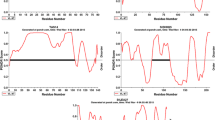Abstract
The wheat dehydrin DHN-5 represents one of the members of the LEA (Late Embryogenesis Abundant) group 2 family. It has been previously shown to play a fundamental role in plant response and adaptation to abiotic stresses. It has also exhibited heat-protecting effect on enzymatic activities. In the present work, we report a number of findings resulting from experimentation and prediction to understand the molecular mechanism underlying the multifunction that may be attributed or directed by the DHN-5 protein. Our analysis showed that DHN-5 was not fixed on the chromatographic affinity resin (Concanavalin A) and did not react with periodic acid used for the staining of glycosylated proteins. These facts reinforced with prediction tools proved that DHN-5 is not glycosylated. In another hand, DHN-5 showed a shift on SDS-PAGE electrophoretic mobility. Eventually, the proposed 3D model of the DHN-5 reinforces their disordered structure. Fold Index and Gold Plot enhance the fact that DHN-5 is an unfolded protein. On the other hand, DHN-5 possesses the ability to chelate ions, like Na+ (86 %), K+ (64 %), Mg2+ (74 %), Cu2+ (77 %), Co2+ (86 %) and Fe2+ (90 %) and could explain the tolerance of transgenic forms of Arabidopsis thaliana plants, containing the DHN-5 gene, against salinity.






Similar content being viewed by others
References
Altschul SF, Gish W, Miller EW, Myers DJ (1990) Lipman, Basic local alignment search tool. J Mol Biol 215:403–410
Bradford MM (1976) A rapid and sensitive method for the quantitation of microgram quantities of protein utilizing the principle of protein–dye binding. Anal Biochem 72:248–254
Brini F, Hanin M, Lumbreras V, Amara I, Khoudi H, Hassairi A, Pagès M, Masmoudi K (2007a) Overexpression of wheat dehydrin DHN-5 enhances tolerance to salt and osmotic stress in Arabidopsis thaliana. Plant Cell Rep 26:2017–2026
Brini F, Hanin M, Lumbreras V, Irar S, Pages M, Masmoudi K (2007b) Functional Characterization of DHN-5, a dehydrin showing a differential phosphorylation pattern in two Tunisian durum wheat (Triticum durum Desf.) varieties with marked differences in salt and drought tolerance. Plant Sci 172:20–28
Brini F, Saibi W, Amara I, Gargouri, Masmoudi K, Hanin M (2010) Wheat dehydrin DHN-5 exerts a heat-protective effect on β-glucosidase and glucose oxidase activities. Biosci Biotechnol Biochem 74:1050–1054
Drira M, Saibi W, Brini F, Gargouri A, Masmoudi K, Hanin M (2013) The K-segments of the wheat dehydrin DHN-5 are essential for the protection of lactate dehydrogenase and β-glucosidase activities in vitro. Mol Biotechnol 54:643–650
Drira M, Saibi W, Amara I, Masmoudi K, Hanin M, Brini F (2015) Wheat dehydrin K-segments ensure bacterial stress tolerance, antiaggregation and antimicrobial effects. Appl Biochem Biotech. doi:10.1007/s12010-015-1502-9
Dure L (1993) A repeating 11-mer amino acid motif and plant desiccation. Plant J 3:363–369
Prilusky J, Felder CE, Zeev-Ben-Mordehai T, Rydberg EH, Man O, Beckmann JS, Silman I, Sussman JL (2005) FoldIndex: a simple tool to predict whether a given protein sequence is intrinsically unfolded. Bioinformatics 21:3435–3438
Hanin M, Brini F, Ebel C, Toda Y, Takeda S, Masmoudi K (2011) Plant dehydrins and stress tolerance: versatile proteins for complex mechanisms. Plant Signal Behav 10:1503–1509
Higgins GG, Sharp PM (1989) Fast and sensitive multiple sequence alignments on micro-computer. CABIOS 5:151–153
Idicula-Thomas S, Balaji PV (2005) Understanding the relationship between the primary structure of proteins and its propensity to be soluble on overexpression in Escherichia coli. Protein Sci 14:582–592
Irar S, Brini F, Goday A, Masmoudi K, Pagès M (2010) Proteomic analysis of wheat embryos with 2-DE and liquid-phase chromatography (ProteomeLab PF-2D)—A wider perspective of the proteome. J Proteomics 731:707–1721
Jensen A, Goday M, Figueras A, Jessop M (1998) Page`s, Phosphorylation mediates the nuclear targeting of the maize Rab17 protein. Plant J 13:691–697
Jere PS, Itzhak K, Richard LJ, Vincent TM (1973) Major glycoprotein of the human erythrocyte membrane: evidence for an amphipathic molecular structure. Arch Biochem Biophys 155:167–183
Jin X, Zhang YX, Wei W, Lu H, Guan ZQ, Wang Z, Chai TY (2008) BjDHNs confer heavy-metal tolerance in plants. Mol Biotechnol 38:91–98
Laemmli UK, Favre M (1973) Maturation of the head of bacteriophage T4. I. DNA packaging events. J Mol Biol 80:575–592
Martin J, Geromanos S, Tempst P, Hartl FU (1993) Identification of nucleotide binding regions in the chaperonin proteins GroEl and GroEs. Nature 366:279–282
Masakazu H, Mitsuru K, Takanari K (2013) A KS-type dehydrin and its related domains reduce Cu-promoted radical generation and the residues contribute to the radical-reducing activities. J Exp Bot 64:1615–1624
Mouillon JM, Gustafsson P, Harryson P (2006) Structural investigation of disordered stress proteins. Comparison of full-length dehydrins with isolated peptides of their conserved segments. Plant Physiol 141:638–650
Radivojac P, Iakoucheva LM, Oldfield CJ, Obradovic Z, Uversky VN, Dunker AK (2007) Intrinsic disorder and functional proteomics. Biophys J 92:1439–1456
Saibi W, Gargouri A (2011) Purification and biochemical characterization of an atypical β-glucosidase from Stachybotrys microspora. J Mol Catal B Enzym 72:107–115
Sang TJ, Tae HK, William K, George G (2011) Bypassing glycosylation: engineering aglycosylated full-length IgG antibodies for human therapy. Curr Opin Biotechnol 22:858–867
Ting L, Bonkovsky H, Guo JT (2011) Structural analysis of heme proteins: implications for design and prediction. BMC Struct Biol 11:1–13
Uversky VN, Dunker AK (2010) Understanding protein non-folding. Biochimica et Biophysica Acta (BBA) Proteins Proteomics 1804:1231–1264
Acknowledgments
This work was supported by grants from the Ministry of Higher Education, Scientific Research and Information Technology and Communication, Tunisia.
Author information
Authors and Affiliations
Corresponding author
Additional information
Communicated by Z. L. Zhang.
Rights and permissions
About this article
Cite this article
Saibi, W., Drira, M., Yacoubi, I. et al. Empiric, structural and in silico findings give birth to plausible explanations for the multifunctionality of the wheat dehydrin (DHN-5). Acta Physiol Plant 37, 52 (2015). https://doi.org/10.1007/s11738-015-1798-7
Received:
Revised:
Accepted:
Published:
DOI: https://doi.org/10.1007/s11738-015-1798-7




